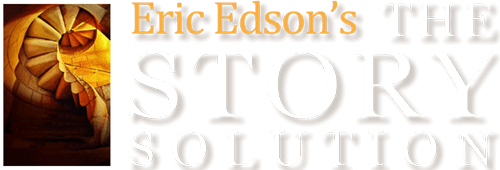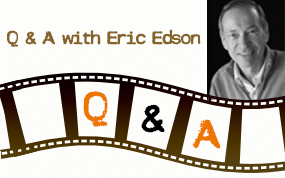
Erica Byrne
SCREEN AND TV WRITER
“Demystifies storytelling and lays out a clear path to a Hollywood sale”

Jessica Davis Stein
NOVELIST
“Like discovering a new continent. May well be the best cure for writer’s block ever written”
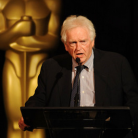
Tom Rickman
ACADEMY AWARD-NOMINATED SCREENWRITER
“Remarkable. Strikes off into new territory”
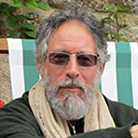
Michael Wiese
PUBLISHER & FILM DIRECTOR
“A brilliant presentation…tremendously valuable to writers everywhere”

Michael Peretzian
SENIOR VP WILLIAM MORRIS AGENCY
“Laser-sharp insight. I could not imagine a more thoughtful and thorough analysis of screenwriting”

Steve White
PRESIDENT OF FEATURE FILMS, NEW WORLD ENTERTAINMENT
“The Rosetta Stone for translating story ideas into powerful screenplays”
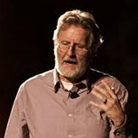
Michael Hauge
BEST SELLING AUTHOR, SCRIPT CONSULTANT
“Brilliant. Invaluable for writers and filmmakers. This book will change the way screenwriting is taught”

Robert Cartland
PRO SERIES PROFESSIONAL SCREENWRITING PROGRAM
“The insight regarding character, dialog and story are elegantly presented. The 23 actions paradigm provides a wonderfully clear blueprint for storytelling”

Jen Grisanti
STORY/CAREER CONSULTANT GRISANTI CONSULTING, INC
“Quenches your thirst to understand the story and how to make yours work better on every level. A must-read for screenwriters”
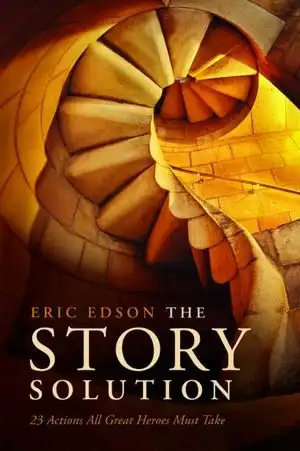
THE STORY SOLUTION is a powerful new book on screenwriting by Eric Edson that will help make your screenplay writing more enjoyable, effective and successful. This book offers a completely unique approach to writing a movie script that will keep producers, agents and audiences glued to their chairs. If you are seeking advice on writing a screenplay or looking for screenwriting tips, Eric Edson’s THE STORY SOLUTION is one of the best screenwriting books to consider for your library. Accomplished screenplay writer and university professor Eric Edson reveals the 23 actions used in every successful movie to create dynamic, three-dimensional heroes while linking together all parts of a captivating screenplay from first page to last. This book offers both new screenplay writers and scriptwriting professionals the tools necessary to construct a forceful emotional ride in their storytelling. Writing screenplays is not easy. Eric’s paradigm of HERO GOAL SEQUENCES has raised his book into Amazon’s top list of the best books on screenwriting. Clear and fun to read, THE STORY SOLUTION brings to light an innovative way to insure effective plotlines for both screenplays and novels.
Buy a copy at Amazon.com or MWP.com
Mr Edson theory about screenplay structure is one of the most important tools every screenplay writer should know, very simple to understand. I bought his book and watched all his YOUTUBE Film Courage virtual classes and personal interviews; he is one of the best teachers I have ever had.
Excellent. Every writer should have this book in his/her how-to library, preferably close by on his writing desk..
"Solution" alright ... for writers! Finally there's a book that provides essential tools for both beginner and expert writers alike. There are scores of screenwriting books out there (I've read most of them) but this one's approach should be read first before all of them. A cinematographer achieves focus via complex optics, lighting and lenses. For a writer to achieve focus, Mr. Edson explains how to critically focus on your hero's specific goals and purpose. To take your hero on an 'emotional' journey will definitely give you the writer (and reader/viewer) clarity like never before. "The Story Solution" has helped me to achieve better focus and structure with my screenwriting. I recommend that you read it, read it again and use it as a guide for all of your writing endeavors. Plus, it's fun!
Eric Edson has unlocked a formula any aspiring/professional screenwriter or revisionist must have in their skill set. Many screenplays have great stories, but lack the pacing required to become a major Hollywood film. These proven 23 actions are seen time and time again throughout many major box office hits such as Die Hard and Collateral (to name a few). By using this method, any story will keep the viewer/reader on the edge of their seat wanting to know what will happen next. Hats off to Eric Edison for discovering a beautiful solution to one of the most common problems for any major Hollywood screenplay.
Wonderful, helpful book on screenwriting. This book has helped me immensely in writing my own screenplay, which I quickly realized I was lost in and I needed some education on it. I took a lot of notes while reading The Story Solution, which is so practical in its guide for writing. It doesn't teach a formula for stories, but it very plainly says, "A hero must have this goal, then another, then these complications must happen," etc., and there are virtually infinite variations for that to keep the audience's interest. That to me makes it more helpful than more abstract books about screenwriting (though those can be very helpful, too). And it's a fun and exciting read. I loved it and will probably re-read it several times.
packed with useful information
Eric Edson's book does a masterful job of taking a difficult and complex subject like story structure and breaks it down into an easy to comprehend rubric. I especially love the plethora of examples from past films showing his "Hero Goal Sequences" at work. Sure, Syd Field can tell you roughly where your act breaks could be in your script, but Edson's book delves deeper into the nitty-gritty of the path your hero needs to take to achieve their goal, and he does it wonderfully.
Professor Eric Edsen, does a great job in presenting how best to write a film play ,or any fiction. He proposes a method that is at once difficult to write but easily understood in terms of how to do it. I am following his guidance and find it delightful, but know in my heart that it will take a while to get it right. Some of his writing processes may well apply to writing non-fiction as well. I highly recommend his book as it will certainly provide the insight from many years of writing experience and observations.
Excellent book for keeping your story moving forward and not going off track. Highly recommend this book.
Usual knowledge not found in any other screenwriting book I've read, and I've read many. An easy read with current examples in film.
This is a book every screenwriter should keep nearby when working on a script. The analogy of screenplay to myth is both helpful and illuminating; it reminds me of Neil Gaiman's illustrated children's book, Instructions, which symbolizes through mythical figures the journey every hero must take in a well-told story. It also echoes Joseph Campbell's Hero of a Thousand Faces, but gives closer inspection to the individual steps of the hero's journey in a contemporary context. It's impossible to look at movies the same way now; I see these 23 steps in all sorts of films (and not just the ones covered in the book). Already I've started incorporating this paradigm into my own writing process; not only have I seen improvements in the strength of my story structure, but all of my characters (let alone the heroes) have more depth. My writing looks and feels more professional, and I'm more confident about achieving success as a screenwriter and bringing evocative, compelling stories to the screen.
With STORY SOLUTION, Eric Edson gives 20-23 (no less than, no greater than) steps that your protagonist must make to have a clear, tight, meaningful story. Don't worry, there's plenty of room for creativity; just check any of your favorite movies---they ALL follow these steps in one way or another. ***FOR BEGINNING SCREENWRITERS: Please don't make the same mistake as me in buying over a dozen books on screenwriting. To be honest, there's more than OVER a dozen good books on screenwriting. But, as happened with me, it's easy to get into READING about writing instead of doing what writers do…….write. For this reason, to save you time and money, I strongly recommend purchasing this book AND Inside Story: The Power of The Transformational Arc (by Dara Marks). The two books give you the BIGGEST advantage in avoiding two of the biggest pitfalls: Weak structure (Story Solution) and deep, emotional story that hooks us from the beginning with CHARACTERS that we care about (Inside Story). I don't mean to recommend the additional book as a knock on SS; I just really find that SS does an EXCELLENT job on structure. Inside Story does an EXCELLENT job on THEME, which Marks blends AMAZINGINGLY into story. But, to return to SS: Over 80% of the screenplays that have issues, poor structure and bland protagonists fill that pile. Make it to the next round of that famous screenwriting contest and purchase this book. Once again, a thoroughly enjoyable read. uabdu87@gmail.com
An incredible help in crafting stories. I have just been using this book for a few weeks and it is transforming my book in progress already. Thank you for the inspiration and support this gives. I recommend it highly! J Frost
I've never reviewed anything on Amazon, but after reading this book, I felt compelled to do so. As an aspiring screenwriter, I searched high and low for the perfect book to guide me on my artistic journey. Needless to say, my shelves are full of numerous screenwriting books and materials. Although there are a few good books out there, most of them say the same thing... write in a three act structure, develop meaningful characters, and keep the audience entertained. Of course, all of this information is useful, but no other book will break down your story into 23 specific parts and walk you through each part in complete clarity like "The Story Solution" by Eric Edson. The good news is that my sense of story dramatically improved after reading this book. The bad news is that I wasted a lot of time and money searching for it. Save yourself the hassle and don't waste money on other screenwriting books (unless you're rich and can afford it). This is the only book you'll need!
This is both a how-to guide and an I depth analysis of many blockbuster motion pictures. The 23 steps still follows classic 3 act structure with buildup to the midpoint and climax, so if you've read a lot of writing guides you may find there's not a whole lot that's new. But I've gotten a lot out of the simplistic way of looking at plot and logic in story telling. Eric Edson is an academic but doesn't write in academese or metaphor, just simple and clear descriptions and examples right out of mainstream movies.
I have been exposed to THE STORY SOLUTION both as a graduate student at California State University Northridge and as adjunct faculty at Boston College. In both cases, I have seen the books influence on the story process. As a screenwriter, I have long struggled with building rising plot actionlines that create powerful script conflict - especially in Act Two. Eric Edson's new "Hero Goal Sequences" story paradigm provides me with a powerful tool to bridge that long - and sometimes lonely - seventy page gap between a solid Act One and a great ending. As an educator responsible for guiding students through their first attempt at writing a feature-length script, I witnessed the students' educational arc go from initial Hero Goal Sequence skepticism to copies of their STORY SOLUTION books highlighted and dog-eared and in constant use as a reference source. The end result has been enormously improved student screenplays. THE STORY SOLUTION is now required reading for the Boston College Film Studies program. It's a valuable tool, and the students are both delighted and grateful to have it. Ned O'Neill Screenwriter/Educator/Story Analyst
Eric Edson's method is great for writing a heart-racing, fast-paced action/thriller. It won't work for every genre, but think "The Sons of Katie Elder" or "Back to the Future" type scripts. The five top books in my script writer's tool box is this one, Save the Cat by Blake Snyder, Story by Mckee, Screenwriter's Bible by David Trottier and Anatomy of a Premise Line by Jeff Lyons. All different approaches for the same or different genres and types of scripts.
Excellent explicit guide to character development and one of the clearest distillations of structure that I have read, with examples from well known films
As an aspiring screenwriter I found "THE STORY SOLUTION" by Eric Edson an amazing resource. This book is an easy read and very helpful. I'm going back to my first three screenplays and applying what I learned from, Eric to improve my stories.
If you've ever read a book on screenwriting, you know that you're nowhere without some sort of story map, some sort of guideline to keep your writing sharp, tight, and filled with meaning so that the reader/audience will be captured at once and will have no choice but to accompany you on the journey you've created. Many of these "maps" fall short of actually helping you stay on course, sequence by sequence, so that there are no story gaps. Eric Edson's "The Story Solution" is the real deal. It's the only toolbox you'll need to help you create a compelling story with characters that jump off the page and get you noticed as a writer. After all, isn't that what we're all looking for?
Heroes. They drive your story. Whether their name is Shrek, Luke Skywalker or George Bailey - they are the characters the audience relates to, understands and becomes as the story progresses. You cannot cut your hero short. They MUST accomplish their goals. Eric Edson does a fantastic job of going over the basics of screenwriting (structure, dialogue, arc, heroes v. villains) before diving into the main concept of his book: The Hero Goal Sequence (c). This is where this book takes off. Diving headlong into the reality of heroes, Mr. Edson explores the core 23 Steps your hero MUST take to accomplish their goal. Using the Hero Goal Sequence (c) paradigm - Mr. Edson defines for the reader/writer the steps it will take for your hero to accomplish his/her goal. He then breaks them down per act, giving the reader/writer a clear understanding of what must happen when and where and for how long. In all the books I've read, I've not seen this definition taken to the lengths that Mr. Edson takes it. And as much the definition may cause others to pause - he gives plenty of examples to hold up his side of the argument. That your hero MUST take these steps to accomplish their goal(s), thus creating a story that resonates and has impact beyond just the final credits. And this is where the book excels. Using these examples as concrete evidence, it's hard to argue the points when he makes them so clearly. Then, taking it one step beyond, he uses exercises to help the reader/writer to really understand the concepts and take their hero(es) to another level. Many books on screenwriting will gloss over, or just lightly touch, on the hero's journey - Eric Edson dives in with a depth rarely seen. The Story Solution takes apart the journey with thoughtful insight and relevance - you'll be amazed at what you find.
excellant!!! Gave me a good basis for story telling in a cinematic way and the steps to incorporate an exciting, intriguing story.
Good book
In The Story Solution, Eric Edson presents a clear, concise, step-by-step manual that will help you to craft your best screenplay yet. There are A LOT of books out there that claim to make you a better screenwriter. This one actually lives up to its promise. It is a fantastic guide to help you through the herculean task of creating a page-turning, commercially viable screenplay. I highly recommend that you purchase it. You will be thrilled with the results you get.
This is a book about plotting a decent story, specifically a screenplay (although the technique works equally well with any sort of story). Part One: Laying the Foundation gives the aspiring writer pointers on how to create a sympathetic hero, how to evoke emotions in your audience, and how to create a dynamic story with believable conflict. Part Two: Creating your Characters covers creating characters based on powerful mythic archetypes and writing dialogue that is integral to advancing your story. These first two sections of the book are full of helpful advice. But the next two sections are the real meat of the book: Part Three: Building Story Structure and Part Four: The Power of Hero Goal Sequences. Part Three covers Basic Screen Story Structure and The Character Growth Arc and Part Four covers The Power of Hero Goal Sequences in great detail - in amount of pages Part Four takes up about half the book. Yes, some of the stuff on basic structure has been said before in other books on plotting and screenwriting. But rarely so clearly and what sets "The Story Solution" apart from others is the amount of detail and the number of examples that Mr Edson uses to illustrate his points. For example, Chapter 14 takes the movie "Up" and breaks it down into the Hero Goal Sequences so the student can clearly see all the mechanics at work. Also the way each of the Hero Goal Sequences is broken down into the kind of events that might happen in each and why, with at least two examples from film scripts for each point. For the student this is pure gold. Didn't get the point after one example? Here's another. Can't see how it all fits together? Check out the movie plan of "Up" at the end of the book broken down into its component parts. The student is not left feeling stupid because she can't work out what the author means because Eric Edson doesn't just make a statement without backing it up. He doesn't assume you'll get it - he first tells you the point then shows it to you in action. Like another reviewer elsewhere I was irritated by the registered trademark symbol that occurred after every instance of the phrase "Hero Goal Sequences". It distracted me and was unnecessary. But that was a small thing compared to the usefulness of the book as a whole. Eric Edson knows his stuff and, what's more to the point, is great at communicating that to an audience. I recommend this book highly for anyone who wants to become a better writer.
Really opened up the inner workings of narrative storytelling—I’m hooked. Now, I’m off to work with this little volume laying open while I type!
An absolute must for writers who utilize and respect the use of an outline. These tools can be used at the micro and macro level which I really enjoy. You can get some help with a brief outline, or use it to create an extremely detailed point-by-point plot with character arcs built-in and ready to go. A great buy!
This amazing book is exactly what its title promises. It details plot twists, or pivotal moments, specifically when and where they must be placed in order to drive the story. Mr. Edson does this by analyzing the plotting of a thousand successful movies and he succeeds in uncovering the crucial element build for a compelling narrative. It"s an exhaustive piece of work that can save any fiction writer from going down that long, wrong, road toward a dead end.
We've all said some variation of the following while watching a crappy movie: "I can write a movie WAY better than this!" Admit it, you have. But have you ever actually tried to sit down and write a 110 page screenplay that makes the reader stay focused from start to finish and by the end they are begging you to find a way to make your script into a movie? Probably not. The reason isn't that your idea sucks, more than likely it's because your story lacks a sense of focus, depth, and momentum. We've all seen movies that lose out interest and even make us leave the theater wondering why anyone wasted their time and money to bring what you just saw to the big screen. Sometimes it's the studio making a movie ultimately suck; but a majority of the time it all goes back to the fundamentals of story. A lot of books - and I mean A LOT of books - have been written about screenwriting. Syd Field, Robert McKee, John Truby, Blake Snyder, Linda Seger, and host of others have mined the mysterious fields of the screenplay in order to tell new and experienced writers the perfect formula for writing a selling script. While these books do their best to make simplify a very complex process, they often become caught up in their own rhetoric and make the new writer so self-aware of rules, formulas, formats, charts and graphs that they freeze and give up without writing a word. So how do you go from frozen in time with your fingers poised over the keys to actually writing and completing a draft of a screenplay? The answer lies in Eric Edson's The Story Solution. This book breaks each aspect of a screenplay down into bite-size pieces that enable the writer to carefully construct their story and have it fully formed before they ever start to write in script format. What I liked best about the book was that it was very conversational. You never feel as if Edson is speaking down to you like some masterful oracle who knows more than you. He uses current films to exemplify his points and he does something other screenwriting books rarely do: he actually has examples of films that DIDN'T work and explains why. While it's nice to learn about The Godfather and why it's a well-structured film, it's also nice to see why other films don't have the amount of story or other aspects needed in order to make them a commercial success. And it makes sense that a film that has a solid story, strong hero, and even stronger villain can generate plenty of success at the box office. Edson shows the reader how to create a protagonist (hero) that audiences will like, how to make that hero change over the course of the film, and what types of characters can be used to help the hero along his journey. I really liked his emphasis on the villain and his explanations as to why the antagonist is so important and instrumental to the overall structure and development of the story and its hero. After a general overview of screenplay/story structure, we get into the meat and potatoes of Edson's genius: Hero Goal Sequences. He posits that each well-written screenplay contains 23 of these sequences that help guide your hero and the audiences through the course of the story. How exactly does it work? Does it really work on any commercially successful film? Edson not only explains in great detail how it works but also uses more than enough examples from commercially successful movies to prove his point. And you know what? It actually works! Each chapter is filled with exercises that allow you to try out Edson's methodology before you even begin the oftentimes harrowing journey into writing an actual script. Once you gain the confidence needed to go forward and take those first few steps you'll quickly come to realize that Edson's approach is an excellent guide to making your story come alive. Not only is the book an ideal must-read for screenwriters and novelists, but it's also a great book for those who just love and enjoy film. I learned a lot about story structure and character that has since made me a more critical thinker when it comes to watching films. Being able to identify and analyze a movie on a deeper level is something that this book enables you to do and in turn makes you a participant in your viewing experience. The Story Solution is a fantastic and entertaining read, a solid instructional tool, and a great way to delve deeper into the world of screenwriting and film. I highly recommend it.
I had a lot of material to somehow shoehorn into an action plot with multiple subplots. External and internal journies with character growth. This book enabled me to break the story down to hero sequences that generated action and emotional character arcs. A big help
The best book I've ever bought!
I held off writing a review of this book for some time. It's take on how to craft a screenplay is new and I didn't want to rush to judgement. Having read the book and worked with it's paradigm, I can say it is perhaps the most effective tool for crafting a focused, hero-driven script I've seen to date. At first glance, this book appears deceptively simple. It's contents and ideas are communicated cleanly and without excess. There's none of the asides I've seen in so many other writing books, asides which usually end up being nothing more that trips down memory lane for a writer trying to highlight moments in their own career. None of that. It's all about communicating Edson's ideas and his remarkable new paradigm. Do not be confused as others who've reviewed the book seem to be. This is not a formula for writing the perfect script. The screenwriting marketplace is full of books that say "you must do this" or "you must do that" by "X" page to create a successful script. This is, as I've said, a paradigm. It takes into account that there must be wiggle room on where certain elements of a story should appear to make a story work. Formulas tend to be far more rigged. I suggest people take time to try to work with the idea of Hero Goals for a while before they rush to judgement. If you really work at it, you'll see this is no simple tool. The idea of Hero Goals forces you to create a logical, connected stream of events that lead the Hero from one task to another in pursuit of a goal. Used wisely, this can be shaped to take any story to a deeper place than one might expect. The idea of Hero Goals forces you to think your story through in ways no other concept has put forth, at least in my opinion. If you use this concept wisely, there will be no floundering around as you muddle your way through Act II. How many times have we all suffered through that torture in the past? Most screen writing books seem to accept the mire that Act II becomes. Not this one. It begs you to spend the time plotting everything out before you put pen to paper. More importantly, applied well, it almost guarantees your hero will not be passive, the curse of so many first drafts. I've always been told, once you've done your homework, writing the script is the fun part. That has rarely been the case before. Using Hero Goals can make for some frustrating days, even weeks, as you do your homework and find the simple, connecting logic between each goal sequence, but once done, writing the script is truly easier and far more enjoyable.
Stories are challenging to write, whether you’re a screenwriter or a novelist. You might have a good idea for how a story could begin, but the middle of the story tends to knock many writers off their game. There are many great books on story structure because structure is what helps many writers get through the slogging middle of their story. Eric Edson’s Story Solution looks at many of the most popular stories and films and digs deep into their underlying structure to show you how you can make structure work for your story. Edson begins the book by laying a solid foundation for storytelling and screenwriting in particular. He argues for storytellers to seek to give audience members an emotional experience through story. He shows how to do this by discussing the role of conflict in story and Story Solution Highlights Edson’s chapter on dialogue is top notch, giving 11 solid principles for writing great dialogue. This is also part of a section on creating great characters, which is also helpful. The most important section of the book is Edson’s Hero Goal Sequences paradigm. He breaks up the major moments of any story into 23 sequences. It’s a helpful paradigm because it shows how the protagonist of a story chases one smaller physical goal as a step toward his main goal until he receives some new information that marks the end of his pursuit of the smaller goal. The end of one goal sequence is followed by the next. I’ve always struggled with how to create sequences of scenes in my stories and how the scenes tie together. The Story Solution went a long way in helping me understand the sequence breakdown of a story. If you’re struggling with how to structure a story you’re working on, Story Solution is a great resource. Review copy provided by Michael Wiese Productions
Eric Edson has uncovered a remarkable truth. His book is fresh, exciting, and groundbreaking. The concept of "Hero Goal Sequences" is incredibly insightful, and presents a process which must change the way screenwriters, agents, producers, and executives conduct business. His observations demystify the essence of successful film, and provide a common language whereby those involved in both the creative and business aspects of film-making may finally understand each another. This is a must read. I am convinced that it is to modern storytelling what Joseph Campbell's "The Hero with a Thousand Faces" was to his time. It will be studied for years to come. Bravo, Mr. Edson. The crowds cheer a shiny, new chariot in what used to be a tired, dusty arena.
I've read about a dozen books like this over the years but this one is the one that has helped me the most. Most books books cover plot, characters, scenes, etc. But no one talk about the order and placement and how you know when you are ready to move on to the next scene. The way Professor Edson writes it-gives you concrete things to work with. I remember when I took a cooking class the chef was very specific on the order to place the ingredigents and the grouping of certain ingredients together. The chef told us to watch for a certain texture in the food. That was signal that it was ready to add more ingredients. This book is the same way. No more driving around in the dark trying out this or that. I love how the Professor says if you your hero doesn't have 4 out of the 6 character traits. Go back and try again. I love that. Its like if you are going to bake bread and you don't put the right amount of yeast along with just the right around of moisture in the bread-it won't come out right and you can't blame the oven! Professor Ed edson is the William Vennard of screen writing! He teaches you the fundamentals so that you have a solid foundation to stand on. The brilliant soprano Renee Fleming always stressed the importance of knowing the fundamentals of how the voice produces sound so that you aren't a victim to the whims of your body, mental stress or environment. The same here-knowing the fundamentals of story telling and all the ingredients that goes into making a great story will give you the freedom and confidence to create your own original story regardless of the whims of the the studio executives or market. Solid story telling will stand time and time again. Thanks professor for this wonderful and much needed book! I am now ready to pull those dusty unfinished screenplays and novels out of the drawers! I feel less frustrated because now I know all the ingredients to the recipes and know when to add them in the pot and how long to cook it!! Run don't walk to get this book. You will be thanking me!
I'm a professional screenwriter and took Eric Edson's class at UCLA several times when I was working towards my certificate in screenwriting because it was simply the best class in structure I'd ever taken. Each semester we analyzed new movies according to his breakdown and it really clicked for me more than just hearing about 3 acts, or 8 sequences that others teach. Eric Edson's breakdown is precise, accurate, and helped me rewrite every one of my scripts. I've used my notes from his classes all those years ago, and was thrilled to find his book at the UCLA bookstore the other day as it contains all the same class information plus much more. Once again, it is helping me figure out what I need to do to fix my latest scripts. Thank you Professor Edson. One of these days I'll owe you a shout out from the Academy Awards!
I have a vast array of books on screenwriting... everyone offers the slightly different solution to the three act structure. Each lends a helping hand to lift me out of the hole I've dug for myself. Story Solution is another rung in my story structure library... enjoy
It has always been for me that by reading books such as "Story Solution" I gain a better understanding of myself and others. This book, more than any other, is helping me to write my screenplay. It is definitely required reading if your going to write any story.
Eric Edson has written seventeen feature screenplays on assignment for companies such as Sony, Warner Brothers, Disney, 20th Century-Fox, ABC Motion Pictures, Lifetime, Showtime, NBC, and TNT. He's also written episodic television. He is Professor of Screenwriting and Director of the Graduate Program in Screenwriting at California State University, Northridge. In his new book, The Story Solution: 23 Steps All Great Heroes Must Take (Michael Wiese Productions 2011), he illuminates new passageways in the story creation process through his unique perspective and opens more doors of opportunity for writers to explore. He shares his secret recipe for creating character sympathy; nine key ingredients that are sure to foster audience identification with your hero or heroine and build an instant, emotional bond between them. As Eric states, "we go to the movies to feel deeply", but before the audience can do that, they must first "care deeply" about the protagonist. He has a simple and effective technique for helping you to create character conflict between the protagonist and antagonist. Eric also guides you through the major-supporting character categories, so you know exactly what each speaking character's function is and whether their purpose is to help or obstruct your heroine or hero. Weaved within Eric's 23 Hero Goal Sequences, which create the Action Storyline, is a three-step, Emotional Storyline; this makes the process of showing your Character Growth Arc much easier. In doing so, your audience can experience a sense of completion as the Heroine/Hero finally lays down their shield of emotional self-protection and achieves emotional freedom, allowing them to connect with others again on a personal level; a life process we all go through, when healing old wounds. In feature films as in life, people need not only a long-term goal, but short-term goals as well to keep them moving forward. The Story Solution provides screenwriters with the necessary steps their protagonists can take to make their journey active, emotionally fulfilling, and complete. I recommend The Story Solution for all screenwriters looking for a fresh, new approach to writing a great story.
Whether you're a novice, or seasoned professional, "The Story Solution: 23 Actions All Great Heroes Must Take" is a must have in your arsenal. Easy to understand, full of examples, and guidance from an established juggernaut in the industry. I highly recommend this book...no, this treasure.
STOP! Save yourself countless wasted hours and don't start writing your screenplay until you've got your 23 Hero Goal sequences firmly in mind! Edson distills the classic screenplay paradigm into a series of steps every hero must take to reach their ultimate goal. This book will keep your narrative on track and accelerating towards an explosive conclusion. Unlike the stacks of novice screenwriting books that cover the same theoretical ground over and over, this book lays down an industry veteran's practical rules for overcoming the real-life screenwriting obstacles we all face.
A must have book for a storyteller. I have a bunch of books about "story" but this is by far one of the best.
As screenwriters, we often start with a great premise or an unforgetable hero. We know some of the conflicts our character must endure in his goal pursuit and the perfect climax. Often though, we are lost in Act II as we work out all the series of events that must take this character through his or her trials. This book will help screenwriters find their second act, and furthermore, help writers avoid passive heroes (a common problem). Are the steps easy to learn? As with anything, it requires a little dedication and effort. You have to approach the book with a sincere desire to learn why other screenplays have been successful. The book breaks down the individual hero goal sequences from numerous films. Edson shows how an active hero goes through phases in his journey, but never ceases to employ some type of effort to attain the goal. Once you analyze the pattern, easily found in many major films, you can see why a book like this was an essential addition to any discussion of film structure. Also, it's a good troubleshooting guide for rewriting a script. Edson's section on character will help you find the missing link between your character arc and his goal pursuit. Or perhaps you're having trouble establishing a midpoint, leading up to the finals strive towards your Act II turning point. Use the sequences to decipher where your screenplay leads your character and how. Then you'll be able to isolate how certain scenes might not build to this midpoint or the turning point in a dramatic way. Thus, this book proves an important text for any serious screenwriter looking for a solidly structured screenplay with active heroes and a high stakes, engaging goal pursuit.
Makes sense. Have learned a lot as a writer from this.
This is a MUST READ for anyone out there wondering how to write a good screenplay. In today's world of too many screenplay books to choose from I'll make it easy for you - just read this one. It breaks things down simply and elegantly. There's a reason why some scripts are just okay and some scripts are truly great. This guy teaches you how to write the truly great kind. You will not be disappointed!!
Extremely helpful, in all regards and at all stages.
Eric Edson was the best screenwriting teacher I had while at CSUN. His book is a reflection of that. Thanks for everything you taught me, Eric.
After reading a variety of "How-To" books on screenwriting, I thought I knew a lot about screen story. I didn't. This is the only book that will walk you through the specific steps your hero must take in order for you to create a successful Hollywood script!
I have been writing using Prof. Edson's theories (as contained in this long-awaited book) for the past 3 years. I can honestly say that it brought my writing to an entirely new level. I used his methodology to craft the story for my recently-released feature film, "
excellent!

